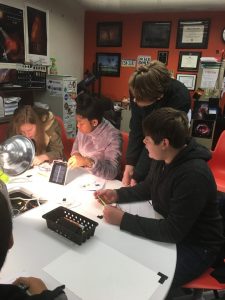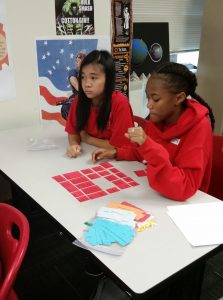By. David Schwenker, Principal at Wake STEM Early College High School
At Wake STEM Early College High School (Wake STEM ECHS) in Wake County, North Carolina the National Academy of Engineering’s (NAE) Grand Challenges for Engineering provide the foundation for STEM education and allow students to see the connections in every aspect of their learning. This small early college located on the campus of North Carolina State University prepares students to enroll in college courses at the university when they enter their junior year of high school. As NC State is a large research-based university and highly ranked in the areas of science and engineering, this high school provides a strong foundation for success not only in STEM careers but in college courses and all future endeavors.
Each Wake STEM teacher, including the humanities staff, must work collaboratively to provide students with a foundation for solving the world’s problems by thinking like an engineer. To guide staff and students, Wake STEM ECHS has set forth three expectations for all classes:
- Each semester-long course must complete two projects.
- Each grade level team must work together to facilitate one integrated project per semester.
- All projects must be based on a Grand Challenge for Engineering, and students must use the Engineering Design Process to guide their project learning.
With these parameters in place and staff fully embracing project-based learning pedagogy, students not only study the NAE Grand Challenges for Engineering but oftentimes work together to create solutions for real-world problems.
Cross-Curricular Integration is Needed to Solve “Grand Challenges for Engineering”
At Wake STEM ECHS, teacher teams collaborate each semester to develop cross-curricular projects based on the Grand Challenges for Engineering that all students in the grade level will complete within their teams. Two of these projects are explained here, along with their connections to the Grand Challenges, student and teacher thoughts, and reflections on the learning that has taken place.
Urban Infrastructure and Access to Clean Water
“The NAE Grand Challenges for Engineering empower students to embrace relevancy, work toward common goals, and invest their skills in a bright future,” says history teacher Andrew Bagwell, co-creator of the ninth-grade ‘State of Water Project’ at Wake STEM ECHS. This interdisciplinary project, based on the Grand Challenges of “Restore and Improve Urban Infrastructure” and “Provide Access to Clean Water,” includes World History, Earth Science and Engineering Design, Spanish, and Math. Throughout this project, students assume roles of political stakeholders, research their position on water use, display and market their information in a trade show format, and participate in a panel discussion to build consensus on the complicated issues surrounding water use in North Carolina while comparing infrastructures found in North Carolina to those in certain Spanish-speaking countries.
As students take on the roles of real estate developer, environmentalist, energy producer, agriculturalist, water regulatory agents, Chamber of Commerce Members, and average voters, they research careers and interview professionals in these positions to answer the guiding question, “How do individuals influence the systems and structures surrounding Urban Infrastructure regarding Access to Clean Water in our community?” Students use their findings to formulate hypotheses about how each group uses water, affects urban infrastructure, manages the nitrogen cycle, and makes political decisions regarding the issue of access to clean water. Students collect and test water samples, use data to support their claims, build displays and models demonstrating water use and conservation, and find common ground with often disparate political views.
Students all experience success as teachers collaborate to schedule checkpoints and monitor group interactions. Students who provided feedback after the project spoke positively. For example, one said, “It was interesting to be put into a career and see how well you support the career and use the information about water quality to back up your statement. It was also interesting to compare water sources and get to research a basin. Also, it was interesting to see how everyone worked together.”
Though projects of this nature take a great deal of pre-planning by the staff and appear to intrude on class time, Mr. Bagwell sums up the experience with this project and the Grand Challenges when he says, “As a History teacher at Wake STEM, I love that this project teaches the interconnectedness of the human experience while at the same time reminding students that history is really just the story of constant improvement toward a brighter tomorrow.”
Access to Clean Water – Every Drop Counts: Global Water and Sanitation Issues
A Long Walk To Water by Linda Sue Park was the foundation for a project completed by eleventh-grade students incorporating English III, Biology, and History as students partnered with the William and Ida Friday Institute for Educational Innovation at NC State. Eighteen small groups of students developed unique research questions based on the NAE Grand Challenge “Provide Access to Clean Water” as they saw how the NAE Grand Challenges for Engineering overlap with United Nations Sustainable Development Goal 6 for 2030.
Through their research and readings, students developed questions for study. For example, one team investigated how women’s health is affected by lack of access to clean water while another group researched the impact of access to clean water on education in other countries. The team of teachers allowed students to form their own questions to guide their research as students produced four digital products including: claims and evidence sheets, an infographic, a call to action handout, and a photojournalistic picture gallery. Some of these items along with a video can be found at this link.
What happens when students work together to solve the Grand Challenges? Not only do they produce artifacts, such as those on the website, but one student responded to the project learning by stating, “It’s more interesting. It’s just better learning for me. It was really a team effort to try to find the essential problem and the solution,” while another student had a life-changing lesson: “We are all humans at the end of the day; we are all in this together.”
The integration between subject areas brought to life the story of Salva Dut and his perseverance in the face of adversity and his commitment to bringing clean and safe water to his native South Sudan. This project inspired students from Wake STEM ECHS to put their research into action. They joined forces and participated in the Iron Giraffe Challenge, raising over $1,000 by hosting a “Walk for Water” and thereby ensuring another well will be built in South Sudan.
One student reflected, “What we do focuses on the real world. It really brought my attention to not only the issues, but what we can do as individuals to solve them.”
Final Notes
By grounding STEM education in the NAE Grand Challenges for Engineering, Wake STEM ECHS students are making an impact around the world. Projects that focus on the NAE Grand Challenges for Engineering force students to ask and solve difficult questions. As Mr. Bagwell states, “After all, what could be a better place to improve the world of tomorrow than in the classrooms of today?”
A special thank you to Andrew Bagwell, History teacher at Wake STEM and Marie Himes, research associate at the Friday Institute for helping with this article.
Author Bio
David Schwenker is the principal at Wake STEM Early College High School. Mr. Schwenker is a 28-year veteran educator who has experienced success leading schools at all levels from pre-K to Early College. He attributes the success of Wake STEM ECHS to the staff and their commitment to focusing their instruction on the Grand Challenges for Engineering.



